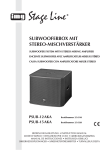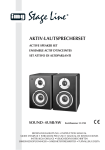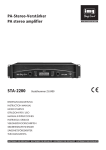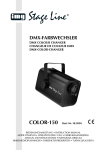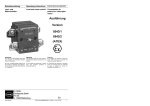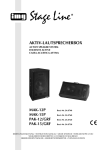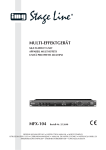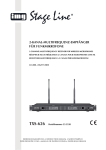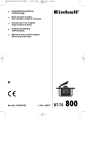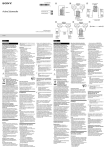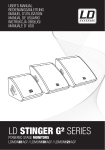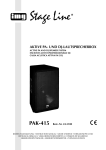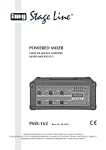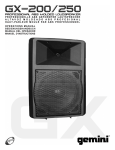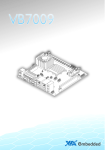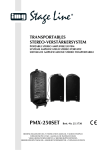Download PAK-10XC PAK-12XC PAK-15XC
Transcript
AKTIV-LAUTSPRECHERBOX ACTIVE SPEAKER SYSTEM ENCEINTE ACTIVE CASSA ACUSTICA ATTIVA PAK-10XC PAK-12XC PAK-15XC Bestellnummer 25.4230 Bestellnummer 25.4240 Bestellnummer 25.4250 BEDIENUNGSANLEITUNG • INSTRUCTION MANUAL MODE D’EMPLOI • ISTRUZIONI PER L’USO • MANUAL DE INSTRUCCIONES INSTRUKCJA OBSŁUGI • VEILIGHEIDSVOORSCHRIFTEN SIKKERHEDSOPLYSNINGER • SÄKERHETSFÖRESKRIFTER • TURVALLISUUDESTA D A CH F B CH Bevor Sie einschalten … GB Before switching on … Wir wünschen Ihnen viel Spaß mit Ihrem neuen Gerät von „img Stage Line“. Bitte lesen Sie diese Bedienungsanleitung vor dem Betrieb gründlich durch. Nur so lernen Sie alle Funktionsmöglichkeiten kennen, vermeiden Fehlbedienungen und schützen sich und Ihr Gerät vor eventuellen Schäden durch unsachgemäßen Gebrauch. Heben Sie die Anleitung für ein späteres Nachlesen auf. We wish you much pleasure with your new “img Stage Line” unit. Please read these operating instructions carefully prior to operating the unit. Thus, you will get to know all functions of the unit, operating errors will be prevented, and yourself and the unit will be protected against any damage caused by improper use. Please keep the operating instructions for later use. Der deutsche Text beginnt auf der Seite 4. The English text starts on page 8. Avant toute installation … I Nous vous souhaitons beaucoup de plaisir à utiliser cet appareil “img Stage Line”. Lisez ce mode dʼemploi entièrement avant toute utilisation. Uniquement ainsi, vous pourrez apprendre lʼensemble des possibilités de fonctionnement de lʼappareil, éviter toute manipulation erronée et vous protéger, ainsi que lʼappareil, de dommages éventuels engendrés par une utilisation inadaptée. Conservez la notice pour pouvoir vous y reporter ultérieurement. Prima di accendere … Vi auguriamo buon divertimento con il vostro nuovo apparecchio di “img Stage Line”. Leggete attentamente le istruzioni prima di mettere in funzione lʼapparecchio. Solo così potete conoscere tutte le funzionalità, evitare comandi sbagliati e proteggere voi stessi e lʼapparecchio da eventuali danni in seguito ad un uso improprio. Conservate le istruzioni per poterle consultare anche in futuro. Il testo italiano inizia a pagina 16. La version française se trouve page 12. E Antes de la utilización … PL Przed uruchomieniem … Zyczymy zadowolenia z nowego produktu “img Stage Line”. Dzięki tej instrukcji obsługi będą państwo w stanie poznać wszystkie funkcje tego urządzenia. Stosując się do instrukcji unikną państwo błędów i ewentualnego uszkodzenia urządzenia na skutek nieprawidłowego użytkowania. Prosimy zachować instrukcję. Le deseamos una buena utilización para su nuevo aparato “img Stage Line”. Por favor, lea estas instrucciones de uso atentamente antes de hacer funcionar el aparato. De esta manera conocerá todas las funciones de la unidad, se prevendrán errores de operación, usted y el aparato estarán protegidos en contra de todo daño causado por un uso inadecuado. Por favor, guarde las instrucciones para una futura utilización. Tekst polski zaczyna się na stronie 24. El texto en español empieza en la página 20. NL B Voor u inschakelt … DK Wij wensen u veel plezier met uw nieuwe apparaat van “img Stage Line”. Lees de veiligheidsvoorschriften grondig door, alvorens het apparaat in gebruik te nemen. Zo behoedt u zichzelf en het apparaat voor eventuele schade door ondeskundig gebruik. Bewaar de handleiding voor latere raadpleging. Før du tænder … Tillykke med dit nye “img Stage Line” produkt. Læs sikkerhedsanvisningerne nøje før ibrugtagning, for at beskytte Dem og enheden mod skader, der skyldes forkert brug. Gem manualen til senere brug. Sikkerhedsanvisningerne findes på side 28. De veiligheidsvoorschriften vindt u op pagina 28. S Innan du slår på enheten … Vi önskar dig mycket glädje med din nya “img Stage Line” produkt. Läs igenom säkerhetsföreskrifterna innan enheten tas i bruk för att undvika skador till följd av felaktig hantering. Behåll instruktionerna för framtida bruk. Säkerhetsföreskrifterna återfinns på sidan 29. FIN Ennen kytkemistä … Toivomme Sinulle paljon miellyttäviä hetkiä uuden “img Stage Line” laitteen kanssa. Ennen laitteen käyttöä pyydämme Sinua huolellisesti tutustumaan turvallisuusohjeisiin. Näin vältyt vahingoilta, joita virheellinen laitteen käyttö saattaa aiheuttaa. Ole hyvä ja säilytä käyttöohjeet myöhempää tarvetta varten. Turvallisuusohjeet löytyvät sivulta 29. w w w.imgstageline.com 2 PAK-10XC 3 D A Auf der ausklappbaren Seite 3 finden Sie alle beschriebenen Bedienelemente und Anschlüsse. CH 1 Übersicht der Bedienelemente und Anschlüsse 1 Eingang MIC IN als XLR-Buchse und Klinkenbuchse (symmetrisch beschaltet) zum Anschluss eines Mikrofons; beim PAK-15XC sind beide Anschlüsse in einer Buchse kombiniert 2 Eingang LINE IN als XLR-Buchse zum Anschluss von Signalquellen mit Line-Pegel (z. B. Mischpult) 3 Eingang LINE IN als Cinch-Buchsen; beim Anschluss beider Buchsen (z. B. Stereosignal von einem CD-Spieler) wird aus den Signalen die Summe (Mono) gebildet. 2 Das Gerät entspricht allen relevanten Richtlinien der EU und ist deshalb mit gekennzeichnet. WARNUNG Das Gerät wird mit lebensgefährlich hoher Netzspannung versorgt. Nehmen Sie deshalb niemals selbst Eingriffe am Gerät vor. Es besteht die Gefahr eines elektrischen Schlages. Beachten Sie auch unbedingt folgende Punkte: G Verwenden Sie das Gerät nur im Innenbereich und schützen Sie es vor Tropf- und Spritzwasser, hoher Luftfeuchtigkeit und Hitze (zulässiger Einsatztemperaturbereich 0 – 40 °C). G Stellen Sie keine mit Flüssigkeit gefüllten Gefäße, z. B. Trinkgläser, auf das Gerät. G Nehmen Sie das Gerät nicht in Betrieb oder ziehen Sie sofort den Netzstecker aus der Steckdose, 1. wenn sichtbare Schäden am Gerät oder am Netzkabel vorhanden sind, 2. wenn nach einem Sturz oder Ähnlichem der Verdacht auf einen Defekt besteht, 3. wenn Funktionsstörungen auftreten. Geben Sie das Gerät in jedem Fall zur Reparatur in eine Fachwerkstatt. G Ziehen Sie den Netzstecker nie am Kabel aus der Steckdose, fassen Sie immer am Stecker an. G Verwenden Sie für die Reinigung nur ein trockenes, weiches Tuch, niemals Wasser oder Chemikalien. G Wird das Gerät zweckentfremdet, nicht richtig installiert, falsch bedient oder nicht fachgerecht repariert, kann keine Haftung für daraus resultierende Sach- oder Personenschäden und keine Garantie für das Gerät übernommen werden. 4 Ausgang LINE OUT als XLR-Buchse und Klinkenbuchse (symmetrisch beschaltet) zum Weiterleiten des Mischsignals z. B. zu einer weiteren Aktiv-Lautsprecherbox 5 Lautstärkeregler MIC LEVEL für den MikrofonEingang MIC IN (1) 6 Lautstärkeregler LINE LEVEL für den Line-Eingang LINE IN (2, 3) 7 Regler MAIN LEVEL für die Gesamtlautstärke 8 Klangregler TREBLE für die Höhen 9 Klangregler BASS für die Tiefen 10 Übersteuerungsanzeige CLIP 11 Betriebsanzeige ON 12 Netzschalter POWER 13 Netzbuchse zum Anschluss an eine Steckdose (230 V~ / 50 Hz) über das beiliegende Netzkabel 14 Halterung für die Netzsicherung Eine durchgebrannte Sicherung nur durch eine gleichen Typs ersetzen. 15 Stativhülse mit Feststellschraube 4 Hinweise für den sicheren Gebrauch Soll das Gerät endgültig aus dem Betrieb genommen werden, übergeben Sie es zur umweltgerechten Entsorgung einem örtlichen Recyclingbetrieb. 3 Einsatzmöglichkeiten Die PAK-10XC, PAK-12XC und PAK-15XC sind leistungsfähige Aktiv-Lautsprecherboxen in stabilen Kunststoffgehäusen. Sie sind vielseitig einsetzbar, z. B. für Tanzveranstaltungen, zur Ausstattung kleinerer Bühnen oder als Monitorlautsprecher in einer Band. Die 2-Wege-Lautsprecherboxen sind mit Klasse-D-Verstärkern ausgestattet, die über einen besonders hohen Wirkungsgrad verfügen. Ein Line-Signal kann über die symmetrisch beschaltete XLR-Buchse oder asymmetrisch über die Cinch-Buchsen zugeführt werden. Zusätzlich verfügen die Geräte über einen Mikrofoneingang, dessen Signal zum Line-Signal dazugemischt werden kann. Der Signalausgang ermöglicht den Anschluss einer weiteren Aktiv-Lautsprecherbox. Die Lautsprecherboxen sind mit Schutzschaltungen gegen Überlastung und Überhitzung ausgestattet. 4 Aufstellen und Anschließen Die Lautsprecherbox auf einen festen Untergrund z. B. auf die Bühne oder einen Tisch stellen und auf die Zuhörer ausrichten. Die Hochtöner sollten sich möglichst auf Ohrhöhe befinden. Mit ihrer abgeschrägten Gehäuseform kann die Box auch als schräg nach oben abstrahlender Bühnenmonitor eingesetzt werden. Soll ein Mikrofon verwendet werden, den Lautsprecher nicht auf das Mikrofon richten und genügend Abstand zum Mikrofon halten, da es sonst zu einer akustischen Rückkopplung (lauter Pfeifton) kommen kann. Alternativ kann die Lautsprecherbox über die Stativhülse in der Unterseite auf ein Standard-Lautsprecherstativ mit 35 mm Rohrdurchmesser gestellt werden (z. B. aus der PAST-Serie von „img Stage Line“). Nach dem Ausrichten der Lautsprecherbox die Schraube (15) festdrehen. Für zusätzliche Montagemöglichkeiten, z. B. Aufhängung, sind M8-Gewindebuchsen in das Gehäuse eingelassen (zwei auf der Oberseite und eine auf der Unterseite). Um diese zu nutzen, die betreffenden Gummiabdeckungen entfernen. Vor dem Anschluss bzw. vor dem Ändern bestehender Anschlüsse die Lautsprecherbox und die anzuschließenden Geräte ausschalten. 4.1 Signalquelle anschließen Für den Anschluss einer Signalquelle mit LinePegel (z. B. CD-Spieler, Mischpultausgang) gibt es folgende Möglichkeiten: D A CH – Für symmetrische Signale eignet sich die XLRBuchse (2) [Belegung der Kontakte Kapitel 6]. – Für asymmetrische Signale eignen sich die Cinch-Buchsen (3). Bei der gleichzeitigen Nutzung beider Cinch-Buchsen oder der CinchBuchsen und der XLR-Buchse (2) werden die Eingangssignale gemischt. Dadurch wird beim Anschluss einer Stereo-Signalquelle ein Monosignal erzeugt. Für die stereophone Wiedergabe jeden Stereokanal an eine eigene Lautsprecherbox anschließen. Ein Mikrofon lässt sich an die XLR-Buchse oder die Klinkenbuchse MIC IN (1) anschließen. Beide Buchsen sind für symmetrische Signale beschaltet. Beim PAK-15XC sind beide Anschlüsse in einer Buchse kombiniert; zum Herausziehen eines XLRSteckers aus dieser Buchse den PUSH-Hebel drücken. Ein Mikrofon mit asymmetrischem Ausgangssignal kann mit einem zweipoligen Klinkenstecker an die Klinkenbuchse angeschlossen werden. 4.2 Signalausgang An der XLR-Buchse und an der (parallel geschalteten) Klinkenbuchse LINE OUT (4) steht das Mischsignal der Eingangssignale zum Weiterleiten zu einer weiteren Aktiv-Lautsprecherbox, einem Verstärker oder einem Aufnahmegerät als symmetrisches Signal mit Line-Pegel zur Verfügung. Das Ausgangssignal ist unabhängig von der Einstellung des Gesamtlautstärkereglers MAIN LEVEL (7). 4.3 Stromversorgung Das beiliegende Netzkabel an die Netzbuchse (13) anschließen und den Stecker in eine Steckdose (230 V~/ 50 Hz) stecken. 5 D 5 A VORSICHT Stellen Sie die Lautstärke nie sehr hoch ein. Hohe Lautstärken können auf Dauer das Gehör schädigen! Das Ohr gewöhnt sich an sie und empfindet sie nach einiger Zeit als nicht mehr so hoch. Darum eine hohe Lautstärke nach der Gewöhnung nicht weiter erhöhen. CH Bedienung Hinweis: Um Schaltgeräusche zu vermeiden, die Aktiv-Lautsprecherbox immer nach der angeschlossenen Signalquelle einschalten und nach dem Gebrauch als erstes Gerät ausschalten. 1) Den Regler MAIN LEVEL (7) zunächst auf Minimum (Linksanschlag) stellen und den Verstärker mit dem Schalter POWER (12) einschalten. Die LED ON (11) leuchtet. Die folgenden Bedienschritte dienen nur als Hilfestellung, es sind auch andere Vorgehensweisen möglich. 2) Zur Grundeinstellung vorerst die LEVEL-Regler (5 – 7) auf Minimum (Linksanschlag) und die Klangregler (8, 9) in die Mittelposition stellen. 3) Mit dem Regler MAIN LEVEL (7) wird die Gesamtlautstärke eingestellt. Den Regler etwa zur Hälfte aufdrehen, sodass die nachfolgenden Einstellungen zu hören sind. 4) Ist eine Signalquelle an den Eingang LINE IN (2, 3) angeschlossen, den dazugehörigen Regler LINE LEVEL (6) soweit aufdrehen, dass der Ton noch nicht verzerrt wiedergegeben wird. 5) Ist ein Mikrofon angeschlossen, dessen Signal mit dem Regler MIC LEVEL (5) dazumischen und wenn erforderlich, den Pegel des Line-Signals mit dem Regler LINE LEVEL (6) reduzieren. VORSICHT! Um ein Rückkopplungspfeifen zu vermeiden, halten Sie das Mikrofon nicht in Richtung des Lautsprechers oder zu nah an ihn heran. Bei einer zu hoch eingestellten Lautstärke kann ebenfalls eine Rückkopplung auftreten. In diesem Fall mit dem Regler MIC LEVEL (5) eine niedrigere Mikrofonlautstärke einstellen. 6 6) Mit den beiden Reglern TREBLE (8) und BASS (9) den Klang wie gewünscht einstellen. 7) Mit dem Regler MAIN LEVEL (7) die gewünschte Gesamtlautstärke einstellen. Den Regler nur so weit aufdrehen, dass der Ton nicht verzerrt wiedergegeben wird. Leuchtet die Übersteuerungsanzeige CLIP (10), den Regler entsprechend zurückdrehen. Bei Bedarf anschließend die Klangeinstellungen korrigieren. 8) Nach dem Gebrauch die Lautsprecherbox mit dem Schalter POWER wieder ausschalten. 6 Technische Daten D A Modell PAK-10XC PAK-12XC PAK-15XC Verstärkerleistung Sinusleistung Spitzenleistung 100 W 170 W 120 W 210 W 150 W 250 W Frequenzbereich 59 – 20 000 Hz 59 – 20 000 Hz 48 – 20 000 Hz Max. Nennschalldruck 115 dB 117 dB 118 dB Basslautsprecher ∅ 25 cm (10″) ∅ 30 cm (12″) ∅ 38 cm (15″) CH dynamischer Hornhochtöner, ∅ 2,54 cm (1″) Hochtonlautsprecher ∅ 34 mm Schwingspule ∅ 44 mm Eingänge (Empfindlichkeit/ max. Eingangsspannung/ Impedanz) LINE IN – XLR, symmetrisch LINE IN – Cinch MIC IN – XLR, symmetrisch MIC IN – Klinke, symmetrisch 100 mV/ 0,6 V/ 10 kΩ 200 mV/ 1,7 V/ 10 kΩ 6 mV/ 120 mV/ 2 kΩ 6 mV/ 120 mV/ 2 kΩ Ausgänge LINE OUT, symmetrisch, XLR und Klinke (parallelgeschaltet) Nennausgangsspannung Ausgangsimpedanz 200 mV 1 kΩ Einsatztemperatur 0 – 40 °C Stromversorgung 230 V~/ 50 Hz 230 V~/ 50 Hz 230 V~/ 50 Hz max. Leistungsaufnahme 200 VA 225 VA 300 VA Abmessungen (B × H × T) 360 × 500 × 270 mm 420 × 585 × 320 mm 470 × 680 × 390 mm Gewicht 12,3 kg 17,1 kg 20 kg Kontaktbelegung der Anschlüsse: 1 = Masse 2 = Signal + 3 = Signal - T = Signal + R = Signal S = Masse Änderungen vorbehalten. Diese Bedienungsanleitung ist urheberrechtlich für MONACOR ® INTERNATIONAL GmbH & Co. KG geschützt. Eine Reproduktion für eigene kommerzielle Zwecke – auch auszugsweise – ist untersagt. 7 GB All operating elements and connections described can be found on the fold-out page 3. 1 Operating Elements and Connections humidity and heat (admissible ambient temperature range 0 – 40 °C). G Do not place any vessels filled with liquid, e. g. drinking glasses, on the unit. G Do not set the unit into operation, or immediately disconnect the mains plug from the mains socket if 1. there is visible damage to the unit or to the mains cable, 2. a defect might have occurred after a drop or similar accident, 3. malfunctions occur. The unit must in any case be repaired by skilled personnel. G Never pull the mains cable to disconnect the mains plug from the mains socket, always seize the plug. G For cleaning only use a dry, soft cloth, never use chemicals or water. G No guarantee claims for the unit and no liability for any resulting personal damage or material damage will be accepted if the unit is used for other purposes than originally intended, if it is not correctly mounted or operated, or not repaired in an expert way. G Important for U. K. Customers! The wires in this mains lead are coloured in accordance with the following code: green/yellow = earth blue = neutral brown = live As the colours of the wires in the mains lead of this appliance may not correspond with the coloured markings identifying the terminals in your plug, proceed as follows: 1. The wire which is coloured green and yellow must be connected to the terminal in the plug which is marked with the letter E or by the earth symbol , or coloured green or green and yellow. 2. The wire which is coloured blue must be connected to the terminal which is marked with the letter N or coloured black. 3. The wire which is coloured brown must be connected to the terminal which is marked with the letter L or coloured red. Warning – This appliance must be earthed. 1 Input MIC IN: XLR jack and 6.3 mm jack (balanced) for connection of a microphone; PAK15XC: both connections are combined in one jack 2 Input LINE IN: XLR jack for connection of signal sources with line level (e. g. mixer) 3 Input LINE IN: phono jacks; when connecting both jacks (e. g. stereo signal from a CD player), the sum (mono) is created from the signals 4 Output LINE OUT: XLR jack and 6.3 mm jack (balanced) for passing on the mixed signal e. g. to another active speaker system 5 Volume control MIC LEVEL for the microphone input MIC IN (1) 6 Volume control LINE LEVEL for the line input LINE IN (2, 3) 7 Control MAIN LEVEL for the total volume 8 Tone control TREBLE for the high range 9 Tone control BASS for the bass range 10 Overload indication CLIP 11 Power LED ON 12 POWER switch 13 Mains jack for connection to a socket (230 V~ / 50 Hz) via the supplied mains cable 14 Support for the mains fuse Only replace a blown fuse by one of the same type 15 Stand sleeve with setscrew 2 Safety Notes The unit corresponds to all relevant directives of the EU and is therefore marked with . WARNING The unit is supplied with hazardous mains voltage. Leave servicing to skilled personnel only. Inexpert handling or modification of the unit may cause an electric shock hazard. It is essential to observe the following items: G 8 The unit is suitable for indoor use only. Protect it against dripping water and splash water, high air If the unit is to be put out of operation definitively, take it to a local recycling plant for a disposal which is not harmful to the environment. 3 Applications The PAK-10XC, PAK-12XC and PAK-15XC are powerful active speaker systems in robust plastic housings. They are suitable for versatile applications, e. g. for dances, for smaller stages or as monitor speakers for bands. The 2-way speaker systems are equipped with class D amplifiers which have an especially high efficiency. A line signal can be fed in via the balanced XLR jack or, in an unbalanced way, via the phono jacks. In addition, the speaker systems are equipped with a microphone input. The signal of this input can be added to the line signal. The signal output will allow connection of another active speaker system. The speaker systems are equipped with protective circuits against overload and overheating. 4 Setting Up and Connecting Set up the speaker system on a solid surface, e. g. on the stage or on a table and position it towards the audience. The tweeters should be at ear level, if possible. With its bevelled cabinet shape, the speaker system can also be used as a stage monitor radiating diagonally upwards. If a microphone should be used, do not direct the speaker to the microphone and keep sufficient distance towards the microphone, otherwise acoustic feedback (loud howling) may occur. Alternatively, place the speaker system via the stand sleeve on its lower side onto a standard speaker stand with 35 mm tube diameter (e. g. of the PAST series from “img Stage Line”). After aligning the speaker system, tighten the screw (15). For additional mounting facilities, e. g. suspension, M8 threaded jacks are recessed into the cabinet (two on the upper side and one on the lower side). To use them, remove the corresponding rubber covers. 4.1 Connecting a signal source GB For connection of a signal source with line level (e. g. CD player, mixer output) there are the following possibilities: – For balanced signals, use the XLR jack (2) [configuration of the pins chapter 6] – For unbalanced signals, use the phono jacks (3). When using both phono jacks or the phono jacks and the XLR jack (2) at the same time, the input signals are mixed. Thus, when connecting a stereo signal source, a mono signal is created. For stereophonic reproduction connect each stereo channel to an individual speaker system. A microphone can be connected to the XLR jack or the 6.3 mm jack MIC IN (1). Both jacks are suitable for balanced signals. PAK-15XC: both connections are combined in one jack; to pull out an XLR plug from this jack, press the PUSH lever. A microphone with unbalanced output signal may be connected to the 6.3 mm jack with a two-pole 6.3 mm plug. 4.2 Signal output The mixed signal of the input signals is available as a balanced signal with line level at the XLR jack and at the 6.3 mm jack LINE OUT (4) [connected in parallel] to be passed on to another active speaker system, an amplifier or a recorder. The output signal is independent of the adjustment of the total volume control MAIN LEVEL (7). 4.3 Power supply Connect the supplied mains cable to the mains jack (13) and the plug to a socket (230 V~ / 50 Hz). Prior to connection or changing existing connections, switch off the speaker system and the units to be connected. 9 GB 5 Operation CAUTION Never adjust a very high volume. Permanent high volumes may damage your hearing! The human ear will get accustomed to high volumes which do not seem to be that high any more after some time. Therefore, do not further increase a high volume after getting used to it. Note: To prevent switching noise, always switch on the active speaker system after the signal source connected and after use switch it off first. 1) Set the control MAIN LEVEL (7) to minimum (left stop) for the time being and switch on the amplifier with the POWER switch (12). The LED ON (11) lights up. The following steps merely serve as an aid, other ways of proceedings are possible. 2) As a basic setting, first set the LEVEL controls (5 to 7) to minimum (left stop) and the tone controls (8, 9) to mid-position. 3) Adjust the total volume with the control MAIN LEVEL (7). Turn up the control approx. half-way so that the following adjustments can be heard. 4) If a signal source has been connected to the input LINE IN (2, 3), turn up the corresponding control LINE LEVEL (6) so that the sound reproduced will not be distorted yet. 5) If a microphone has been connected, add its signal with the control MIC LEVEL (5) and, if required, reduce the level of the line signal with the control LINE LEVEL (6). CAUTION! To prevent a howling noise, do not hold the microphone in the direction of the speaker or too close to it. If a volume has been adjusted too high, a howling noise may occur as well. In this case adjust a lower microphone volume with the control MIC LEVEL (5). 10 6) Adjust the sound as desired with both controls TREBLE (8) and BASS (9). 7) Adjust the desired total volume with the control MAIN LEVEL (7). Only turn up the control so that the sound reproduced will not be distorted. If the overload LED CLIP (10) lights up, turn back the control accordingly. If required, readjust the sound. 8) After use, always switch off the speaker system with the POWER switch. 6 Specifications GB Model PAK-10XC PAK-12XC PAK-15XC Amplifier power RMS power peak power 100 W 170 W 120 W 210 W 150 W 250 W Frequency range 59 – 20 000 Hz 59 – 20 000 Hz 48 – 20 000 Hz Max. rated SPL 115 dB 117 dB 118 dB Bass speaker ∅ 25 cm (10″) ∅ 30 cm (12″) ∅ 38 cm (15″) dynamic horn tweeter, ∅ 2.54 cm (1″) Tweeter ∅ 34 mm voice coil Inputs (sensitivity/ max. input voltage / impedance) LINE IN – XLR, balanced LINE IN – phono MIC IN – XLR, balanced MIC IN – 6.3 mm, balanced ∅ 44 mm 100 mV/ 0.6 V/ 10 kΩ 200 mV/ 1.7 V/ 10 kΩ 6 mV/ 120 mV/ 2 kΩ 6 mV/ 120 mV/ 2 kΩ Outputs LINE OUT, balanced, XLR and 6.3 mm jacks (connected in parallel) rated output voltage output impedance 200 mV 1 kΩ Ambient temperature 0 – 40 °C Power supply 230 V~/ 50 Hz 230 V~/ 50 Hz 230 V~/ 50 Hz Max. power consumption 200 VA 225 VA 300 VA Dimensions (W × H × D) 360 × 500 × 270 mm 420 × 585 × 320 mm 470 × 680 × 390 mm Weight 12.3 kg 17.1 kg 20 kg Pin configuration of the connections: 1 = ground 2 = signal + 3 = signal - T = signal + R = signal S = ground Subject to technical modification. All rights reserved by MONACOR ® INTERNATIONAL GmbH & Co. KG. No part of this instruction manual may be reproduced in any form or by any means for any commercial use. 11 F B Ouvrez le présent livret page 3, dépliable, de manière à visualiser les éléments et branchements. 2 1 AVERTISSEMENT Lʼappareil est alimenté par une tension dangereuse. Ne touchez jamais lʼintérieur de lʼappareil, vous pourriez subir une décharge électrique. CH Eléments et branchements 1 Entrée MIC IN, XLR femelle et jack 6,35 femelle (symétrique) pour brancher un microphone ; sur la PAK-15XC, les deux branchements sont combinés en une prise 2 Entrée LINE IN, XLR femelle, pour brancher des sources de signal avec niveau ligne (par exemple table de mixage) 3 Entrée LINE IN, prises RCA : lorsque les deux prises sont branchées (par exemple signal stéréo dʼun lecteur CD), la somme (mono) est formée à partir des signaux 4 Sortie LINE OUT, XLR femelle et jack 6,35 femelle (symétrique) pour diriger le signal de mixage par exemple vers une autre enceinte active 5 Réglage de volume MIC LEVEL pour lʼentrée micro MIC IN (1) 6 Réglage de volume LINE LEVEL pour lʼentrée ligne LINE IN (2, 3) 7 Réglage MAIN LEVEL pour le volume général 8 Réglage de tonalité TREBLE pour les aigus 9 Réglage de tonalité BASS pour les graves 10 Témoin dʼécrêtage CLIP 11 Témoin de fonctionnement ON 12 Interrupteur secteur POWER 13 Prise secteur à brancher via le cordon secteur livré à une prise 230 V~ / 50 Hz. 14 Porte-fusible : tout fusible fondu doit être remplacé uniquement par un fusible de même type 15 Insert pour pied avec vis de fixation Conseils dʼutilisation et de sécurité Lʼappareil répond à toutes les directives nécessaires de lʼUnion européenne et porte donc le symbole . Respectez scrupuleusement les points suivants : G Lʼappareil nʼest conçu que pour une utilisation en intérieur. Protégez-le de tout type de projections dʼeau, des éclaboussures, dʼune humidité élevée de lʼair et de la chaleur (plage de température de fonctionnement autorisée : 0 – 40 °C). G En aucun cas, vous ne devez poser dʼobjet contenant du liquide ou un verre sur lʼappareil. G Ne faites pas fonctionner lʼappareil ou débranchez la fiche secteur immédiatement du secteur lorsque : 1. des dommages visibles apparaissent sur lʼappareil ou le cordon secteur, 2. après une chute ou un cas similaire, vous avez un doute sur lʼétat de lʼappareil, 3. des défaillances apparaissent. Dans tous les cas, les dommages doivent être réparés par un technicien spécialisé. G Ne débranchez jamais lʼappareil en tirant sur le cordon secteur, tenez-le toujours par la fiche. G Pour le nettoyer, utilisez uniquement un chiffon sec et doux, en aucun cas, de produits chimiques ou dʼeau. G Nous déclinons toute responsabilité en cas de dommages matériels ou corporels consécutifs si lʼappareil est utilisé dans un but autre que celui pour lequel il a été conçu, sʼil nʼest pas correctement monté, utilisé ou sʼil nʼest pas réparé par une personne habilitée ; de même, la garantie deviendrait caduque. Lorsque lʼappareil est définitivement retiré du service, vous devez le déposer dans une usine de recyclage adaptée pour contribuer à son élimination non polluante. 12 3 Possibilités dʼutilisation Les enceintes PAK-10XC, PAK-12XC et PAK-15XC sont des enceintes actives puissantes proposées dans des ébénisteries plastiques solides. Elles peuvent être utilisées pour tout type dʼapplications, par exemple manifestations de danse, équipements de petites scènes ou haut-parleurs moniteur dans un groupe. Les enceintes 2 voies sont dotées dʼamplificateurs classe D avec un rendement particulièrement élevé. Un signal ligne peut être dirigé via la prise XLR symétrique ou via les prises RCA en asymétrique. De plus, les appareils disposent dʼune entrée micro dont le signal peut être mixé au signal ligne. La sortie signal permet de brancher une autre enceinte active. Les enceintes sont dotées de circuits de protection contre les surcharges et surchauffes. 4 Positionnement et branchements Placez lʼenceinte sur une surface fixe par exemple sur scène ou sur une table et orientez-la vers les auditeurs. Les haut-parleurs dʼaigu devraient être placés si possible à hauteur dʼoreille. Grâce à sa forme trapézoïdale, lʼenceinte peut être utilisée comme moniteur de scène diffusant vers le haut en diagonale. Si un microphone doit être utilisé, nʼorientez pas lʼenceinte vers le micro et laissez une distance suffisante avec le micro sinon des effets larsen peuvent survenir. Elle peut également être placée sur un pied dʼenceinte avec diamètre de tube de 35 mm grâce à lʼinsert pour pied sur la face inférieure (par exemple série PAST de “img Stage Line”). Une fois lʼenceinte positionnée, serrez la vis (15). Pour dʼautres possibilités de montage, par exemple suspension, des vis filetées M8 sont placées dans lʼenceinte (deux sur la face supérieure et une sur la face inférieure). Pour les utiliser, retirez les caches caoutchouc respectifs. 4.1 Branchement dʼune source de signal F Pour brancher une source de signal avec niveau ligne (par exemple lecteur CD, sortie table de mixage), plusieurs possibilités sʼoffrent à vous : CH B – pour des signaux symétriques, utilisez la prise XLR femelle (2) [configuration des contacts, chapitre 6]. – pour des signaux asymétriques, utilisez les prises RCA (3). Si vous utilisez simultanément les prises RCA ou les prises RCA et la prise XLR (2), les signaux dʼentrée sont mixés. Ainsi lorsquʼon branche une source stéréo de signal, un signal mono est créé. Pour une restitution stéréo, reliez chaque canal stéréo à une enceinte distincte. On peut relier un microphone à la prise XLR femelle ou à la prise jack 6,35 MIC IN (1) ; les deux prises sont configurées pour des signaux symétriques. Sur la PAK-15XC, les deux branchements sont combinés dans une prise ; pour retirer la fiche XLR mâle de la prise, appuyez sur le levier PUSH. Un microphone avec signal de sortie asymétrique peut être branché à la fiche jack 6,35 mâle avec une fiche jack 6,35 2 pôles. 4.2 Sortie signal Le signal de mixage des signaux dʼentrée est présent à la prise XLR femelle et à la prise jack LINE OUT (4) [branchée en parallèle] comme signal symétrique avec niveau ligne pour être dirigés vers une autre enceinte active, un amplificateur ou un enregistreur. Le signal de sortie est indépendant du réglage du volume général MAIN LEVEL (7). 4.3 Alimentation Reliez le cordon secteur livré à la prise secteur (13) et reliez la fiche à une prise secteur 230 V~ / 50 Hz. Avant dʼeffectuer les branchements ou de modifier les branchements existants, éteignez lʼenceinte et les appareils à relier. 13 F 5 B PRECAUTION Ne réglez pas jamais le volume trop fort. Un volume trop élevé peut, à long terme, générer des troubles de lʼaudition. Lʼoreille humaine sʼhabitue à des volumes élevés et ne les perçoit plus comme tels au bout dʼun certain temps. Nous vous conseillons donc de régler le volume et de ne plus le modifier. CH Utilisation Conseil : pour éviter tout bruit fort de commutation, allumez lʼenceinte active toujours après la source de signal reliée et après utilisation, éteignez-la en premier. 1) Mettez dʼabord le réglage MAIN LEVEL (7) sur le minimum (butée de gauche) et allumez lʼamplificateur avec lʼinterrupteur POWER (12). La LED ON (11) brille. Les points suivants sont des aides de réglage, il existe dʼautres méthodes. 2) Comme réglage de base, mettez tout dʼabord les réglages LEVEL (5 – 7) sur le minimum (butée de gauche) et mettez les réglages de tonalité (8, 9) sur la position médiane. 3) Avec le réglage MAIN LEVEL (7), réglez le volume général souhaité. Tournez le réglage à la moitié environ pour que les réglages suivants soient audibles. 4) Si une source de signal est reliée à lʼentrée LINE IN (2, 3), tournez le réglage correspondant LINE LEVEL (6) jusquʼà ce que le son soit restitué de manière non distordue. 5) Si un micro est relié, mixez son signal avec le réglage MIC LEVEL (5) et si besoin, diminuez le niveau du signal ligne avec le réglage LINE LEVEL (6). ATTENTION ! Pour éviter les sifflements, ne tenez pas le micro en direction de lʼenceinte ou trop près dʼelle. Si le volume réglé est trop élevé, un sifflement peut également intervenir. Dans ce cas, réglez un volume micro plus faible avec le réglage MIC LEVEL (5). 14 6) Avec les deux réglages TREBLE (8) et BASS (9), réglez la tonalité comme souhaité. 7) Avec le réglage MAIN LEVEL (7), réglez le volume général souhaité. Tournez le réglage de telle sorte que le son soit restitué de manière non distordu. Si la LED CLIP (10) brille, tournez le réglage dans lʼautre sens. Si besoin, corrigez les réglages de tonalité. 8) Après utilisation, éteignez lʼenceinte avec lʼinterrupteur POWER. 6 Caractéristiques techniques F B Modèle PAK-10XC PAK-12XC PAK-15XC Puissance amplificateur Puissance RMS Puissance max. 100 W 170 W 120 W 210 W 150 W 250 W Bande passante 59 – 20 000 Hz 59 – 20 000 Hz 48 – 20 000 Hz Pression sonore max. 115 dB 117 dB 118 dB Haut-parleur de grave ∅ 25 cm (10″) ∅ 30 cm (12″) ∅ 38 cm (15″) CH aigu dynamique à pavillon, ∅ 2,54 cm (1″) Haut-parleur dʼaigu ∅ 34 mm bobine ∅ 44 mm Entrées (sensibilité / tension dʼentrée max. / impédance) LINE IN – XLR, symétrique LINE IN – RCA MIC IN – XLR, symétrique MIC IN – jack, symétrique 100 mV/ 0,6 V/ 10 kΩ 200 mV/ 1,7 V/ 10 kΩ 6 mV/ 120 mV/ 2 kΩ 6 mV/ 120 mV/ 2 kΩ Sorties LINE OUT, symétrique, XLR et jack (branchées en parallèle) Tension de sortie nominale Impédance de sortie 200 mV 1 kΩ Température fonc. 0 – 40 °C Alimentation 230 V~/ 50 Hz 230 V~/ 50 Hz 230 V~/ 50 Hz Consommation max. 200 VA 225 VA 300 VA Dimensions (L × H × P) 360 × 500 × 270 mm 420 × 585 × 320 mm 470 × 680 × 390 mm Poids 12,3 kg 17,1 kg 20 kg Configuration des contacts des branchements : 1 = Masse 2 = Signal + 3 = Signal - T = Signal + R = Signal S = Masse Tout droit de modification réservé. Notice dʼutilisation protégée par le copyright de MONACOR ® INTERNATIONAL GmbH & Co. KG. Toute reproduction même partielle à des fins commerciales est interdite. 15 I A pagina 3, se aperta completamente, vedrete tutti gli elementi di comando e i collegamenti descritti. 1 Elementi di comando e collegamenti 1 Ingresso MIC IN come presa XLR e presa jack (bilanciata) per il collegamento di un microfono; nel PAK-15XC, i due contatti sono combinati in una sola presa 2 Ingresso LINE IN come presa XLR per il collegamento di sorgenti di segnali con livello Line (p. es. mixer) 3 Ingresso LINE IN come prese RCA; collegando le due prese (p. es. segnale stereo di un lettore CD), dai segnali si crea la somma (mono). 4 Uscita LINE OUT come presa XLR e presa jack (bilanciata) per inoltrare il segnale miscelato, p. es. ad unʼulteriore cassa attiva 2 AVVERTIMENTO Lʼapparecchio funziona con pericolosa tensione di rete. Non intervenire mai personalmente al suo interno. Esiste il pericolo di una scarica elettrica. Si devono osservare assolutamente anche i seguenti punti: G Usare lʼapparecchio solo allʼinterno di locali e proteggerlo dallʼacqua gocciolante e dagli spruzzi dʼacqua, da alta umidità dellʼaria e dal calore (temperatura dʼimpiego ammessa fra 0 e 40 °C). G Non depositare sullʼapparecchio dei contenitori riempiti di liquidi, p. es. bicchieri. G Non mettere in funzione lʼapparecchio e staccare subito la spina dalla presa di rete se: 1. lʼapparecchio o il cavo rete presentano dei danni visibili; 2. dopo una caduta o dopo eventi simili sussiste il sospetto di un difetto; 3. lʼapparecchio non funziona correttamente. Per la riparazione rivolgersi sempre ad unʼofficina competente. G Staccare il cavo rete afferrando la spina, senza tirare il cavo. G Per la pulizia usare solo un panno morbido, asciutto; non impiegare in nessun caso acqua o prodotti chimici. G Nel caso dʼuso improprio, dʼinstallazione scorretta, dʼimpiego scorretto o di riparazione non a regola dʼarte dellʼapparecchio, non si assume nessuna responsabilità per eventuali danni consequenziali a persone o a cose e non si assume nessuna garanzia per lʼapparecchio. 5 Regolatore volume MIC LEVEL per lʼingresso microfono MIC IN (1) 6 Regolatore volume LINE LEVEL per lʼingresso LINE IN (2, 3) 7 Regolatore MAIN LEVEL per il volume globale 8 Regolatore toni TREBLE per gli alti 9 Regolatore toni BASS per i bassi 10 Spia di sovrapilotaggio CLIP 11 Spia di funzionamento ON 12 Interruttore di rete POWER 13 Presa per il collegamento con una presa di rete (230 V~ / 50 Hz) tramite il cavo in dotazione 14 Portafusibile Sostituire un fusibile difettoso sempre con uno dello stesso tipo. 15 Boccola per stativo con vite di bloccaggio 16 Avvertenze di sicurezza Questʼapparecchio è conforme a tutte le direttive rilevanti dellʼUE e pertanto porta la sigla . Se si desidera eliminare lʼapparecchio definitivamente, consegnarlo per lo smaltimento ad unʼistituzione locale per il riciclaggio. 3 Possibilità dʼimpiego I PAK-10XC, PAK-12XC e PAK-15XC sono casse acustiche attive potenti in contenitori robusti di plastica. Si possono impiegare in vari modi, p. es. su piste di ballo, per spettacoli minori o come altoparlanti monitor di una band. Le casse a 2 vie sono equipaggiati con amplificatori di classe D che dispongono di un rendimento particolarmente alto. Tramite la presa XLR bilanciata o tramite le prese RCA sbilanciate è possibile inserire un segnale Line. In più, gli apparecchi dispongono di un ingresso per microfono il cui segnale può essere miscelato nel segnale Line. Lʼuscita dei segnali permette il collegamento di unʼulteriore cassa acustica attiva. Le casse sono equipaggiate con circuiti di protezione contro sovraccarico e surriscaldamento. 4 Collocare e collegare Sistemare la cassa su una base stabile, p. es. sul palcoscenico e su un tavolo, e orientarla verso gli ascoltatori. I tweeter dovrebbero trovasi, se possibile, allʼaltezza dellʼorecchio delle persone. Data la forma smussata della cassa, la si può usare anche come monitor con irradiazione diretta in modo obliquo verso lʼalto. Se si deve usare un microfono, non orientare la cassa verso il microfono e mantenere una distanza sufficiente fra cassa e microfono per escludere il feedback acustico (un fischio forte). In alternativa, per mezzo della boccola per stativo sul lato inferiore, la cassa può essere sistemata su uno stativo standard per casse acustiche con diametro del tubo di 35 mm (p. es. della serie PAST di “img Stage Line”). Dopo aver orientato la cassa, stringere bene la vite di bloccaggio (15). Per ulteriori possibilità di montaggio, p. es. in modo sospeso, nella cassa si trovano delle boccole filettate M8 (due sul lato superiore e una sul lato inferiore). Per usarle occorre togliere le loro coperture di gomma. 4.1 Collegare la sorgente di segnali I Per il collegamento di una sorgente di segnali con livello Line (p. es. lettore CD, uscita di un mixer) esistono le seguenti possibilità: – Per i segnali bilanciati è adatta la presa XLR (2) [piedinatura dei contatti Capitolo 6]. – Per i segnali sbilanciati sono adatte le prese RCA (3). Se si usano contemporaneamente le due prese RCA o le prese RCA e la presa XLR (2), i segnali dʼingresso saranno miscelati. In questo modo, collegando una sorgente stereo, si genera un segnale mono. Per la riproduzione stereo, collegare ogni canale stereo con una sua cassa acustica. Un microfono può essere collegato con la presa XLR o jack MIC IN (1). Entrambe le prese sono previste per segnali bilanciati. Nel PAK-15XC i due contatti sono combinati in una sola presa; per sfilare un connettore XLR da questa presa, esercitare una pressione sulla levetta PUSH. Un microfono con segnale dʼuscita sbilanciato può essere collegato con la presa jack per mezzo di un jack a 2 poli. 4.2 Uscita dei segnali Alla presa XLR e alla presa jack (collegata in parallelo) LINE OUT (4) è disponibile il segnale miscelato dei segnali dʼingresso come segnale bilanciato con livello Line, per essere inoltrato a unʼulteriore cassa attiva, a un amplificatore o a un registratore. Il segnale dʼuscita non dipende dallʼimpostazione del regolatore del volume globale MAIN LEVEL (7). 4.3 Alimentazione Inserire il cavo in dotazione nella presa (13) e quindi in una presa di rete (230 V~ / 50 Hz). Prima di effettuare i collegamenti o di modificare dei collegamento esistenti, spegnere la cassa e gli apparecchi da collegare. 17 I 5 Funzionamento ATTENZIONE Mai tenere molto alto il volume. A lungo andare, il volume eccessivo può procurare danni allʼudito! Lʼorecchio si abitua agli alti volumi e dopo un certo tempo non se ne rende più conto. Perciò non aumentare il volume successivamente. Nota: Per evitare rumori di commutazione, accendere la cassa attiva sempre dopo la sorgente collegata di segnali, e dopo lʼuso spegnerla per prima. 1) Portare il regolatore MAIN LEVEL (7) per il momento sul minimum (arresto a sinistra) e accendere lʼamplificatore con lʼinterruttore POWER (12). Il LED ON (11) si accende. I passi seguenti servono solo come aiuto, perché sono possibili anche altri modi di procedere. 2) Per il momento, per unʼimpostazione base portare i regolatori LEVEL (5 – 7) sul minimum (arresto a sinistra) e spostare i regolatori toni (8, 9) in posizione centrale. 3) Con il regolatore MAIN LEVEL (7) sʼimposta il volume globale. Aprire il regolatore a metà circa, in modo che le impostazioni seguenti siano udibili. 4) Se allʼingresso LINE IN (2, 3) è collegata una sorgente di segnali, aprire il relativo regolatore LINE LEVEL (6) al punto tale che lʼaudio non sia riprodotto in modo distorto. 5) Se è collegato un microfono, aggiungere il suo segnale con il regolatore MIC LEVEL (5) e, se necessario, ridurre il livello del segnale Line tramite il regolatore LINE LEVEL (6). ATTENZIONE! Per escludere il fischio di feedback, non tenere il microfono in direzione dellʼaltoparlante oppure troppo vicino allo stesso. Anche con un volume impostato troppo alto è possibile che si manifesti un feedback. In questo caso impostare con il regolatore MIC LEVEL (5) un volume minore del microfono. 18 6) Con i due regolatori TREBLE (8) e BASS (9) impostare i toni secondo desiderio. 7) Con il regolatore MAIN LEVEL (7) impostare il volume globale desiderato. Aprire il regolatore solo al punto che lʼaudio non sia riprodotto in modo distorto. Se si accende la spia di sovrapilotaggio CLIP (10), ridurre il regolatore in corrispondenza. Se necessario correggere successivamente le impostazioni dei toni. 8) Dopo lʼuso, spegnere la cassa con lʼinterruttore POWER. 6 Dati tecnici I Modello PAK-10XC PAK-12XC PAK-15XC Potenza dellʼamplificatore Potenza efficace Potenza di picco 100 W 170 W 120 W 210 W 150 W 250 W Gamma di frequenza 59 – 20 000 Hz 59 – 20 000 Hz 48 – 20 000 Hz Pressione sonora nom.le max. 115 dB 117 dB 118 dB Woofer ∅ 25 cm (10″) ∅ 30 cm (12″) ∅ 38 cm (15″) tweeter dinamico a tromba, ∅ 2,54 cm (1″) Tweeter ∅ 34 mm Bobina mobile Ingressi (Sensibilità / Tensione max. dʼingresso / Impedenza) LINE IN – XLR, bilanciato LINE IN – RCA MIC IN – XLR, bilanciato MIC IN – jack, bilanciato ∅ 44 mm 100 mV/ 0,6 V/ 10 kΩ 200 mV/ 1,7 V/ 10 kΩ 6 mV/ 120 mV/ 2 kΩ 6 mV/ 120 mV/ 2 kΩ Uscite LINE OUT, bilanciato, XLR e jack (collegati in parallelo) Tensione nominale dʼuscita Impedenza dʼuscita 200 mV 1 kΩ Temperatura dʼesercizio 0 – 40 °C Alimentazione 230 V~/ 50 Hz 230 V~/ 50 Hz 230 V~/ 50 Hz Potenza assorbita max. 200 VA 225 VA 300 VA Dimensioni (l × h × p) 360 × 500 × 270 mm 420 × 585 × 320 mm 470 × 680 × 390 mm Peso 12,3 kg 17,1 kg 20 kg Piedinatura dei contatti: 1 = Massa 2 = Segnale + 3 = Segnale - T = Segnale + R = Segnale S = Massa Con riserva di modifiche tecniche. La MONACOR ® INTERNATIONAL GmbH & Co. KG si riserva ogni diritto di elaborazione in qualsiasi forma delle presenti istruzioni per lʼuso. La riproduzione – anche parziale – per propri scopi commerciali è vietata. 19 E Todos los elementos de funcionamiento y las conexiones que se describen pueden encontrarse en la página 3 desplegable. 1 Elementos de Funcionamiento y Conexiones 1 Entrada MIC IN: Toma XLR y jack 6,3 mm (simétrica) para conectar un micrófono; PAK-15XC: ambas conexiones están combinadas en una toma 2 Entrada LINE IN: Toma XLR para conectar fuentes de señal con nivel de línea (p. ej. mezclador) 3 Entrada LINE IN: Tomas phono; cuando se conectan ambas tomas (p. ej. señal estéreo de un lector CD), se crea la suma (mono) de las señales 2 ADVERTENCIA El aparato está alimentado con un voltaje peligroso. Deje el mantenimiento en manos del personal cualificado. El manejo inexperto o la modificación del aparato pueden provocar una descarga. Es imprescindible que preste atención a los puntos siguientes: G El aparato está adecuado para su utilización sólo en interiores. Protéjalo de goteos y salpicaduras, elevada humedad del aire y calor (temperatura ambiente admisible: 0 – 40 ºC). G No coloque ningún recipiente lleno de líquido encima del aparato, como por ejemplo un vaso. G No ponga el aparato en funcionamiento o desconecte inmediatamente el enchufe de la toma de corriente si: 1. Existe algún daño visible en el aparato o en el cable de corriente. 2. Aparece algún defecto por caída o accidente similar. 3. No funciona correctamente. Sólo el personal cualificado puede reparar el aparato bajo cualquier circunstancia. G No tire nunca del cable de corriente para desconectar el enchufe de la toma de corriente, tire siempre del enchufe. G Utilice sólo un paño suave y seco para la limpieza, no utilice nunca ni productos químicos ni agua. G No podrá reclamarse garantía o responsabilidad alguna por cualquier daño personal o material resultante si el aparato se utiliza para otros fines diferentes a los originalmente concebidos, si no se utiliza o se monta adecuadamente o no se repara por expertos. 4 Salida LINE OUT: Toma XLR y jack 6,3 mm (simétrica) para enviar la señal mezclada p. ej. a otro recinto activo 5 Control de volumen MIC LEVEL para la entrada de micrófono MIC IN (1) 6 Control de volumen LINE LEVEL para la entrada de línea LINE IN (2, 3) 7 Control MAIN LEVEL para el volumen total 8 Control de tono TREBLE para los agudos 9 Control de tono BASS para los graves 10 Indicación de sobrecarga CLIP 11 LED ON de corriente 12 Interruptor POWER 13 Toma de corriente para la conexión a un enchufe (230 V~ / 50 Hz) mediante el cable de corriente entregado 14 Soporte para el fusible de corriente Cambie siempre un fusible fundido sólo por otro del mismo tipo 15 Vaso para pie con tornillo de cierre 20 Notas de Seguridad El aparato cumple con todas las directivas relevantes de la UE y por lo tanto está marcado con el símbolo . Si va a poner el aparato fuera de servicio definitivamente, llévelo a la planta de reciclaje más cercana para que su eliminación no perjudique el medioambiente. 3 Aplicaciones Los PAK-10XC, PAK-12XC y PAK-15XC son recintos activos potentes en carcasa de plástico robusto. Están adecuados para una gran variedad de aplicaciones, p. ej. en salas de baile, pequeños escenarios o como altavoces monitor para grupos. Los recintos de 2 vías están equipados con amplificadores de la clase D, que tienen una eficiencia especialmente elevada. Se puede alimentar una señal de línea mediante la toma XLR simétrica o, en modo asimétrico, mediante las tomas phono. Además, los recintos están equipados con una entrada de micrófono. La señal de esta entrada se puede añadir a la señal de línea. La salida de señal permitirá conectar otro recinto activo. Los recintos están equipados con circuitos de protección contra sobrecargas y sobrecalentamientos. 4 Colocación y Conexión Ponga el recinto en una superficie sólida, p. ej. en el escenario o en una mesa y diríjalo hacia la audiencia. Los tweeters deberían estar a la altura de los oídos, si es posible. Con su forma de recinto biselado, el recinto también se puede utilizar como monitor de escenario radiando hacia arriba en diagonal. Si hay que utilizar un micrófono, no dirija el altavoz hacia el micrófono y mantenga distancia suficiente con el micrófono, de lo contrario puede aparecer feedback acústico (pitido estridente). Como alternativa, coloque el recinto con el vaso para pie de su parte inferior en un pie de recinto estándar con un diámetro de tubo de 35 mm (p. ej. de la gama PAST de “img Stage Line”). Después de alinear el recinto, fije el tornillo (15). Para instalaciones de montaje adicionales, p. ej. en suspensión, hay tomas roscadas M8 empotradas en el recinto (dos en la parte superior y una en la inferior). Para utilizarlas, extraiga las tapas de caucho correspondientes. 4.1 Conexión de una fuente de señal E Para conectar una fuente de señal con nivel de línea (p. ej. lector CD, salida de mezclador) tiene las siguientes opciones: – Para señales simétricas, utilice la toma XLR (2) [configuración de los pines apartado 6] – Para señales asimétricas, utilice las tomas phono (3). Si se utilizan ambas tomas phono o las tomas phono y la toma XLR (2) al mismo tiempo, se mezclan las señales de entrada. De este modo, cuando se conecta una fuente de señal estéreo, se crea una señal mono. Para una reproducción estereofónica, conecte cada canal estéreo a un recinto individual. Se puede conectar un micrófono a la toma XLR o al jack 6,3 mm MIC IN (1). Ambas tomas están adecuadas para señales simétricas. PAK-15XC: Ambas conexiones se combinan en una toma; para sacar un conector XLR de esta toma, pulse la palanca PUSH. Un micrófono con señal de salida asimétrica puede conectarse al jack 6,3 mm con un conector jack 6,3 mm de dos polos. 4.2 Salida de señal La señal mezclada de las señales de entrada está disponible como señal simétrica con nivel de línea en la toma XLR y en el jack 6,3 mm LINE OUT (4) [conectado en paralelo] para enviarse a otro recinto activo, a un amplificador o a un grabador. La señal de salida es independiente del ajuste del control de volumen total MAIN LEVEL (7). 4.3 Alimentación Conecte el cable de corriente entregado a la toma de corriente (13) y el conector a un enchufe (230 V~ / 50 Hz). Antes de conectar o modificar cualquier conexión existente, desconecte el recinto y todos los aparatos conectados. 21 E 5 Funcionamiento ADVERTENCIA No ajuste nunca un volumen muy elevado. Los volúmenes altos permanentes pueden dañar su oído. El oído humano se acostumbra a los volúmenes altos que no lo parecen tanto después de un rato. Por lo tanto, no aumente un volumen alto después de acostumbrarse a él. Nota: Para prevenir el ruido de conexión, conecte siempre el recinto activo después de la fuente de señal conectada y desconéctelo en primer lugar cuando acabe. 1) Ponga el control MAIN LEVEL (7) al mínimo (tope izquierdo) primero y conecte el amplificador con el interruptor POWER (12). Se iluminará el LED ON (11). Los siguientes pasos sirven simplemente como ayuda, hay otros procedimientos posibles. 2) Como ajuste básico, ponga primero los controles LEVEL (5 a 7) al mínimo (tope izquierdo) y los controles de tono (8, 9) en la posición intermedia. 3) Ajuste el volumen total con el control MAIN LEVEL (7). Aumente el control aprox. hasta la mitad de modo que se pueden escuchar los ajustes siguientes. 4) Si se ha conectado una fuente de señal a la entrada LINE IN (2, 3), aumente el control correspondiente LINE LEVEL (6) sin que el sonido reproducido se distorsione. 5) Si se ha conectado un micrófono, añada su señal con el control MIC LEVEL (5) y, si es necesario, reduzca el nivel de la señal de línea con el control LINE LEVEL (6). ¡PRECAUCIÓN! Para prevenir zumbidos, no mantenga el micrófono en la dirección del altavoz o muy cerca de él. Si se ha ajustado un volumen demasiado alto, también puede aparecer algún zumbido. En este caso, ajuste un volumen de micrófono inferior con el control MIC LEVEL (5). 22 6) Ajuste el sonido como quiera con los controles TREBLE (8) y BASS (9). 7) Ajuste el volumen total que desee con el control MAIN LEVEL (7). Aumente el control siempre que el sonido no se distorsione. Si el LED CLIP de sobrecarga (10) se ilumina, baje el control según corresponda. Si es necesario, reajuste el sonido. 8) Después de utilizarlo, desconecte el recinto con el interruptor POWER. 6 Especificaciones E Modelo PAK-10XC PAK-12XC PAK-15XC Potencia de amplificación Potencia RMS Potencia de pico 100 W 170 W 120 W 210 W 150 W 250 W Banda pasante 59 – 20 000 Hz 59 – 20 000 Hz 48 – 20 000 Hz SPL máx. 115 dB 117 dB 118 dB Altavoz de graves ∅ 25 cm (10″) ∅ 30 cm (12″) ∅ 38 cm (15″) Tweeter dinámico, ∅ 2,54 cm (1″) Tweeter ∅ 34 mm Bobina Entradas (sensibilidad / voltaje máx. de entrada / impedancia) LINE IN – XLR, simétrica LINE IN – phono MIC IN – XLR, simétrica MIC IN – jack 6,3 mm, simétrica ∅ 44 mm 100 mV/ 0,6 V/ 10 kΩ 200 mV/ 1,7 V/ 10 kΩ 6 mV/ 120 mV/ 2 kΩ 6 mV/ 120 mV/ 2 kΩ Salidas LINE OUT, simétricas, tomas jack 6,3 mm y XLR (conectadas en paralelo) Voltaje de salida nominal Impedancia de salida 200 mV 1 kΩ Temperatura ambiente 0 – 40 °C Alimentación 230 V~/ 50 Hz 230 V~/ 50 Hz 230 V~/ 50 Hz Consumo máximo 200 VA 225 VA 300 VA Dimensiones (B × H × P) 360 × 500 × 270 mm 420 × 585 × 320 mm 470 × 680 × 390 mm Peso 12,3 kg 17,1 kg 20 kg Configuración de pines de las conexiones: 1 = masa 2 = señal + 3 = señal - T = señal + R = señal S = masa Sujeto a modificaciones técnicas. Manual de instrucciones protegido por el copyright de MONACOR ® INTERNATIONAL GmbH & Co. KG. Toda reproducción mismo parcial para fines comerciales está prohibida. 23 PL Proszę otworzyć instrukcję na stronie 3. Pokazano tam rozkład opisanych elementów operacyjnych oraz złączy. 2 Środki bezpieczeństwa Urządzenie spełnia wszystkie wymagania norm UE dzięki czemu jest oznaczone symbolem . UWAGA 1 Elementy operacyjne i złącza 1 Wejście MIC IN: gniazdo XLR oraz 6,3 mm (symetryczne) do podłączania mikrofonu; PAK15XC: oba złącza w gnieździe Combo 2 Wejście LINE IN: gniazdo XLR do podłączania źródła sygnału z wyjściem liniowym (np. miksera) Urządzenie jest zasilane wysokim napięciem sieciowym. Wszelkie naprawy należy zlecić przeszkolonemu personelowi; nieodpowiednia obsługa może spowodować porażenie prądem elektrycznym. Należy przestrzegać następujących zasad: G Urządzenie jest przeznaczone tylko do użytku wewnątrz pomieszczeń. Należy chronić je przed działaniem wody, dużej wilgotności powietrza oraz wysokiej temperatury (dopuszczalny zakres 0 – 40 °C). G Na urządzeniu nie należy stawiać żadnych pojemników z płynem np. szklanek. G Nie wolno włączać urządzenia lub natychmiast odłączyć wtyczkę zasilającą z gniazdka 1. jeżeli stwierdzono istnienie widocznego uszkodzenia urządzenia, lub kabla zasilającego, 2. jeżeli uszkodzenie urządzenia mogło nastąpić w wyniku upadku lub innego podobnego zdarzenia, 3. jeżeli urządzenie działa nieprawidłowo. W każdym przypadku, naprawę należy zlecić specjaliście. G Nie wolno odłączać urządzenia z gniazdka sieciowego ciągnąc za kabel zasilania, należy zawsze chwytać za wtyczkę. 13 Gniazdo zasilania do łączenia z gniazdkiem sieciowym (230 V~ / 50 Hz) za pomocą dołączonego kabla zasilającego G Do czyszczenia należy używać suchej, miękkiej tkaniny. Nie stosować wody ani chemicznych środków czyszczących. 14 Pokrywa bezpiecznika Spalony bezpiecznik wymieniać na nowy o identycznych parametrach. G Producent ani dostawca nie ponoszą odpowiedzialności za wynikłe szkody: uszkodzenie sprzętu lub obrażenia użytkownika, jeśli urządzenie było używane niezgodnie z ich przeznaczeniem, nieprawidłowo zamontowane, podłączone lub obsługiwane bądź poddane nieautoryzowanej naprawie. 3 Wejście LINE IN: gniazda phono; po podłączeniu obu gniazd (np. dla sygnału stereo z odtwarzacza CD), sygnały są sumowane do postaci mono 4 Wyjście LINE OUT: gniazdo XLR oraz 6.3 mm (symetryczne) do przesyłania zmiksowanego sygnału np. do kolejnego aktywnego zestawu głośnikowego 5 Regulator głośności MIC LEVEL dla wejścia mikrofonowego MIC IN (1) 6 Regulator głośności LINE LEVEL dla wejścia liniowego LINE IN (2, 3) 7 Regulator MAIN LEVEL głośności całkowitej 8 Regulator barwy TREBLE dla wysokich tonów 9 Regulator barwy BASS dla niskich tonów 10 Wskaźnik przesterowania CLIP 11 Dioda Power ON 12 Włącznik POWER 15 Gniazdo na statyw ze śrubą blokującą Po całkowitym zakończeniu eksploatacji, urządzenie należy oddać do punktu recyklingu, aby nie zaśmiecać środowiska. 24 3 Zastosowanie PAK-10XC, PAK-12XC oraz PAK-15XC są aktywnymi zestawami głośnikowymi o dużej mocy, w wytrzymałych obudowach z tworzywa sztucznego. Mogą pracować w wielu systemach, np. w salach tanecznych, w klubach muzycznych lub na scenie, w charakterze monitora podłogowego. Dwudrożna konstrukcja wyposażona jest w cyfrowe wzmacniacze klasy D o wysokiej efektywności. Do podłączania sygnałów liniowych można wykorzystać symetryczne gniazda XLR oraz niesymetryczne gniazda phono. Dodatkowo, zestawy posiadają wejście mikrofonowe. Sygnały z wejść podawane są równocześnie na wyjście liniowe, umożliwiające podłączenie kolejnego aktywnego zestawu głośnikowego. Zestawy głośnikowe wyposażono w obwody zabezpieczające przed przeciążeniem oraz przegrzaniem. 4 Przygotowanie do pracy i podłączanie Ustawić zestaw głośnikowy na solidnym podłożu, np. na scenie lub na stole i skierować przodem do słuchaczy. Zalecane jest ustawienie na takiej wysokości, aby głośnik wysokotonowy znajdował się na poziomie ucha. Alternatywnie do ustawienia na gumowych nóżkach, zestaw głośnikowy można położyć na boku, aby pracował w charakterze odsłuchu podłogowego. W przypadku używania mikrofonu, należy zwrócić uwagę na to, aby znajdował się on w odpowiedniej odległości oraz nie był on skierowany w kierunku głośnika gdyż może to spowodować powstanie sprzężenia akustycznego. Alternatywnie, umieścić zestaw głośnikowy na standardowym statywie o średnicy rury 35 mm (np. serii PAST marki “img Stage Line”), wykorzystując gniazdo na spodniej stronie. Po ustawieniu na statywie, dokręcić śrubę blokującą (15). Istnieją także inne sposoby montażu głośnika. W tym celu dostępne są otwory z gwintem M8 (dwa na górze i jeden na dole). Przed ich wykorzystaniem należy wyjąć gumowe zaślepki. 4.1 Podłączanie źródeł dźwięku PL Do podłączania źródła sygnału z wyjściem liniowym (np. wyjścia miksera lub odtwarzacza CD), dostępne są wejścia: – Dla sygnałów symetrycznych, gniazdo XLR (2) [konfiguracja pinów rozdz. 6] – Dla sygnałów niesymetrycznych, gniazda phono (3). W przypadku równoczesnego wykorzystywania obu gniazd phono lub gniazd phono oraz XLR (2), sygnały zostają zmiksowane. Ponadto, sygnał stereo miksowany jest do postaci mono. Aby uzyskać stereofoniczną emisję, należy podać każdy kanał na osobny zestaw głośnikowy. Do podłączania mikrofonu służą gniazda XLR oraz 6,3 mm MIC IN (1), przystosowane do sygnałów symetrycznych. Zestaw PAK-15XC: Oba złącza zrealizowane są przez gniazdo Combo; aby odłączyć wtyk XLR od gniazda, wcisnąć blokadę PUSH. Do podłączania mikrofonu z niesymetrycznym wyjściem, wykorzystać 2-polowy wtyk 6,3 mm. 4.2 Wyjście przelotowe Zmiksowany sygnał ze wszystkich wejść dostępny jest na gnieździe XLR LINE OUT (4) i pozwala na [równoległe] podłączenie kolejnego aktywnego zestawu głośnikowego, wzmacniacza lub rejestratora. Poziom sygnału na tym wyjściu nie zależy od ustawienia regulatora MAIN LEVEL (7). 4.3 Zasilanie Podłączyć, znajdujący się w zestawie, kabel zasilający do gniazda zasilania (13), a następnie do gniazdka sieciowego (230 V~ / 50 Hz). Przed przystąpieniem do podłączania lub zmiany połączeń należy bezwzględnie wyłączyć zestaw głośnikowy oraz podłączane urządzenia. 25 PL 5 Obsługa UWAGA Nigdy nie ustawiać bardzo dużej głośności wzmacniacza! Stały, bardzo wysoki poziom dźwięku może uszkodzić narząd słuchu. Ucho ludzkie adaptuje się do wysokiego poziomu dźwięku, który po pewnym czasie nie jest już percepowany jako wysoki. Dlatego nie wolno przekraczać raz już ustawionego maksymalnego poziomu głośności. Uwaga: Aby uniknąć trzasku w głośniku, należy włączać aktywny zestaw głośnikowy na końcu, po włączeniu wszystkich źródeł sygnału, a wyłączać jako pierwszy. 1) Ustawić regulator MAIN LEVEL (7) na minimum (maksymalnie w lewo) na czas uruchamiania, a następnie włączyć wzmacniacz przełącznikiem POWER (12). Zapali się dioda ON (11). Opisana poniżej kolejność czynności jest przykładowa. 2) Początkowo, ustawić regulatory LEVEL (5 do 7) na minimum (maksymalnie w lewo), a regulatory barwy (8, 9) w pozycję środkową. 3) Ustawić regulator głośności całkowitej MAIN LEVEL (7) na około na połowę zakresu, aby wprowadzane ustawienia były słyszalne. 4) Jeżeli podłączono źródło sygnału do wejścia LINE IN (2, 3), ustawić odpowiedni regulator LINE LEVEL (6) na taki poziom głośności, aby sygnał nie został przesterowany. 5) Jeżeli podłączono mikrofon, dodać jego sygnał za pomocą regulatora MIC LEVEL (5) oraz, jeżeli trzeba, zredukować poziom sygnału liniowego regulatorem LINE LEVEL (6). UWAGA! Aby uniknąć powstania sprzężenia akustycznego, zachować odpowiedni dystans i nie kierować mikrofonu w stronę zestawu głośnikowego. Sprzężenie może powstać również przypadku wysokich poziomów głośności. Należy wówczas zmniejszyć poziom sygnału mikrofonowego regulatorem MIC LEVEL (5). 26 6) Ustawić barwę dźwięku regulatorami TREBLE (8) oraz BASS (9). 7) Ustawić żądany poziom głośności całkowitej regulatorem MAIN LEVEL (7) na taki poziom głośności, aby sygnał nie został przesterowany. Jeżeli zapala się dioda CLIP (10), sygnał ma zbyt wysoki poziom. Należy wówczas skręcić regulator. 8) Po zakończeniu użytkowania, wyłączyć urządzenie przełącznikiem POWER. 6 Specyfikacja PL Model PAK-10XC PAK-12XC PAK-15XC Moc wzmacniacza moc rms moc szczytowa 100 W 170 W 120 W 210 W 150 W 250 W Pasmo przenoszenia 59 – 20 000 Hz 59 – 20 000 Hz 48 – 20 000 Hz Max SPL 115 dB 117 dB 118 dB Głośnik basowy ∅ 25 cm (10″) ∅ 30 cm (12″) ∅ 38 cm (15″) dynamiczny tubowy, ∅ 2,54 cm (1″) Wysokotonowy ∅ 34 mm cewka ∅ 44 mm Wejścia (czułość / max napięcie wejściowe /impedancja) LINE IN – XLR, symetryczne LINE IN – phono MIC IN – XLR, symetryczne MIC IN – 6,3 mm, symetryczne 100 mV/ 0,6 V/ 10 kΩ 200 mV/ 1,7 V/ 10 kΩ 6 mV/ 120 mV/ 2 kΩ 6 mV/ 120 mV/ 2 kΩ Wyjście LINE OUT, symetryczne, (gniazda XLR oraz 6,3 mm zrównoleglone) napięcie wyjściowe impedancja wyjściowa 200 mV 1 kΩ Zakres temperatur 0 – 40 °C Zasilanie 230 V~/ 50 Hz 230 V~/ 50 Hz 230 V~/ 50 Hz Max pobór mocy 200 VA 225 VA 300 VA Wymiary (S × W × G) 360 × 500 × 270 mm 420 × 585 × 320 mm 470 × 680 × 390 mm Waga 12,3 kg 17,1 kg 20 kg Konfiguracja pinów złączy: 1 = mase 2 = sygnał + 3 = sygnał - T = sygnał + R = sygnał S = mase Z zastrzeżeniem możliwości zmian. Instrukcje obsługi są chronione prawem copyright for MONACOR ® INTERNATIONAL GmbH & Co. KG. Przetwarzanie całości lub części instrukcji dla osobistych korzyści finansowych jest zabronione. 27 NL B Aktieve luidsprekerbox Aktivt højttalersystem Lees aandachtig de onderstaande veiligheidsvoorschriften, alvorens het toestel in gebruik te nemen. Mocht u bijkomende informatie over de bediening van het toestel nodig hebben, lees dan de Engelse tekst van deze handleiding. Læs nedenstående sikkerhedsoplysninger opmærksomt igennem før ibrugtagning af enheden. Bortset fra sikkerhedsoplysningerne henvises til den engelske tekst. Veiligheidsvoorschriften Vigtige sikkerhedsoplysninger Dit apparaat is in overeenstemming met alle vereiste EU-Richtlijnen en is daarom met gekenmerkt. Denne enhed overholder alle nødvendige EUdirektiver og er som følge deraf mærket . WAARSCHUWING De netspanning (230 V~) van het apparaat is levensgevaarlijk. Open het apparaat niet, want door onzorgvuldige ingrepen loopt u het risico van elektrische schokken. ADVARSEL Let eveneens op het volgende: G Het apparaat is enkel geschikt voor gebruik binnenshuis. Vermijd druip- en spatwater, uitzonderlijk warme plaatsen en plaatsen met een hoge vochtigheid (toegestaan omgevingstemperatuur: 0 – 40 °C). G Plaats geen bekers met vloeistof zoals drinkglazen etc. op het apparaat. Dette produkt benytter 230 V~. Overlad al servicering til autoriserede personer. Ukyndig håndtering kan føre til elektrisk stød. Vær altid opmærksom på følgende: G Enheden er kun beregnet til indendørs brug. Beskyt den mod vanddråber og -stænk, høj luftfugtighed og varme (tilladt omgivelsestemperatur 0 – 40 °C). G Undgå at placere væskefyldte genstande, som f. eks. glas, ovenpå enheden. G Schakel het toestel niet in resp. trek onmiddellijk de stekker uit het stopcontact, 1. wanneer het apparaat of het netsnoer zichtbaar beschadigd is, 2. wanneer er een defect zou kunnen optreden nadat het apparaat bijvoorbeeld is gevallen, 3. wanneer het apparaat slecht functioneert. Het apparaat moet in elk geval worden hersteld door een gekwalificeerd vakman. Tag ikke enheden i brug og tag straks stikket ud af stikkontakten i følgende tilfælde: 1. hvis der er synlig skade på enheden eller netkablet. 2. hvis der kan være opstået skade, efter at enheden er tabt eller lignende. 3. hvis der forekommer fejlfunktion. Enheden skal altid repareres af autoriseret personel. G G Trek de stekker nooit met het snoer uit het stopcontact, maar met de stekker zelf. Tag aldrig netstikket ud af stikkontakten ved at trække i kablet, tag fat i selve stikket. G G Verwijder het stof met een droge, zachte doek. Gebruik zeker geen water of chemicaliën. Til rengøring må kun benyttes en tør, blød klud; der må under ingen omstændigheder benyttes kemikalier eller vand. G In geval van ongeoorloofd of verkeerd gebruik, verkeerde aansluiting, foutieve bediening of van herstelling door een niet-gekwalificeerd persoon vervalt de garantie en de verantwoordelijkheid voor hieruit resulterende materiële of lichamelijke schade. G Hvis enheden benyttes til andre formål, end den oprindeligt er beregnet til, hvis den ikke er korrekt tilsluttet, hvis den betjenes forkert, eller hvis den ikke repareres af autoriseret personel, omfattes eventuelle skader ikke af garantien. G Wanneer het apparaat definitief uit bedrijf wordt genomen, bezorg het dan voor milieuvriendelijke verwerking aan een plaatselijk recyclagebedrijf. 28 DK Hvis enheden skal tages ud af drift for bestandigt, skal den bringes til en lokal genbrugsstation for bortskaffelse. S Aktiv Högtalare System FIN Aktiivikaiutin Innan enheten tas i bruk, läs noga igenom säkerhetsföreskrifterna. För ytterligare information, läs den Engelska delen av bruksanvisningen. Ole hyvä ja huomioi aina seuraavat turvallisuutta koskevat ohjeet ennen laitteen käyttöön ottoa. Katso käyttöön liittyviä ohjeita myös Englanninkielisistä ohjeista, jos tarvitset lisää tietoa laitteen käytöstä. Säkerhetsföreskrifter Turvallisuudesta Enheten uppfyller samtliga Eu-direktiv och har därför försett med symbolen . Laite vastaa kaikkia vaadittuja EU direktiivejä, joten se on varustettu merkinnällä. VARNING Enheten använder högspänning internt (230 V~). Överlåt all service till auktoriserad personal. Egna ingrepp kan ge elektriska överslag med risk för skada på person och/eller materiel. VAROITUS Tämä laite toimii vaarallisella 230 V~ jännitteellä. Laiteen huolto tulee tehdä siihen valtuutetun huollon toimesta. Asiaa tuntematon käsittely voi aiheuttaa sähköiskun vaaran. Ge även akt på följande: Huomioi seuraavat seikat: G Enheten är endast avsedd för inomhusbruk. Skydda enheten mot vätskor, hög luftfuktighet och hög värme (tillåten omgivningstemperatur 0 – 40 °C). G Laitteet soveltuvat vain sisätilakäyttöön. Suojele niitä kosteudelta, vedeltä ja kuumuudelta (sallittu ympäröivä lämpötila 0 – 40 °C). G G Placera inte föremål innehållande vätskor, t. ex. dricksglas, på enheten. Älä sijoita laitteen päälle mitään nestettä sisältävää, kuten vesilasia tms. G G Använd inte enheten och tag omedelbart ut kontakten ur eluttaget om något av följande uppstår: 1. Enheten eller elsladden har synliga skador. 2. Enheten är skadad av fall e. d. 3. Enheten har andra felfunktioner. Enheten skall alltid lagas av kunnig personal. G Drag aldrig ur kontakten genom att dra i sladden, utan ta tag i kontaktkroppen. Älä kytke virtaa päälle ja irrota laite välittömästi sähköverkosta jos: 1. laitteessa tai virtajohdossa on näkyvä vika. 2. laite on saattanut vaurioitua pudotuksessa tai vastaavassa tilanteessa. 3. laite toimii väärin. Kaikissa näissä tapauksissa laitteen saa korjata vain hyväksytty huolto. G G Rengör endast med en mjuk och torr trasa, använd aldrig kemikalier eller vatten vid rengöring. Älä koskaan irrota virtajohtoa pistorasiasta johdosta vetämällä. G G Om enheten används på annat sätt än som avses, om den inte kopplas in ordentligt, om den används på fel sätt eller inte repareras av auktoriserad personal upphör alla garantier att gäll. I dessa fall tas inget ansvar för uppkommen skada på person eller materiel. Käytä puhdistamiseen pelkästään kuivaa, pehmeää kangasta. Älä käytä kemikaaleja tai vettä. G Laitteen takuu raukeaa, eikä valmistaja, maahantuoja tai myyjä ota vastuuta mahdollisista välittömistä tai välillisistä vahingoista, jos laitetta on käytetty muuhun kuin alkuperäiseen käyttötarkoitukseen, laitetta on taitamattomasti käytetty tai kytketty tai jos laitetta on huollettu muussa kuin valtuutetussa huollossa. Om enheten skall kasseras skall den lämnas till återvinning. Kun laite poistetaan lopullisesti käytösta, vie se paikalliseen kierrätyskeskukseen jälkikäsittelyä varten. 29 ® MONACOR INTERNATIONAL GmbH & Co. KG • Zum Falsch 36 • 28307 Bremen • Germany Copyright © by MONACOR INTERNATIONAL. All rights reserved. A-1311.99.01.02.2012






























